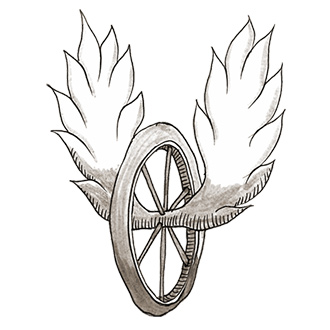
Related Questions
- Can we control machines using only our thoughts?
- Can humans fly like birds?
- Can seawalls prevent beaches from eroding?
- Why do submarines move more like torpedoes than fish?
- What do Legos have to do with engineering?
- Can we build a time machine?
- Can better helmets make football safer?
- Is it possible to make a Batman suit?
- What are the technological obstacles to colonizing another planet?
- How does a particle accelerator work, and why are such large structures necessary?
Why is a bicycle easier to control when it’s moving?
A moving bike is always falling, steering prevents (or delays) impact…
By Sarah JensenImagine a bike messenger paused at a stop light: he leans over his front wheel, making small adjustments and tiny twists in his handlebars. He stays up on two wheels — unless he turns the handlebars a bit too far, or a car bumps him, or a sudden gust of wind blows him into the curb. “When you’re moving,” says David Gordon Wilson, professor emeritus of mechanical engineering, “you’re able to steer under the fall.”
Imagine a broomstick balanced in your palm, he suggests. “It’s the same principle. You can wiggle your hand and keep the broomstick standing up for a long while. Whichever way the broomstick starts to fall, your hand stays under the fall and keeps it upright.” When you’re on a bike, Wilson says, “if it begins to slope, you automatically turn in the direction of the fall and your bike stays vertical.”
The length of a bike’s trail — the distance between where the front wheel touches the road and where the steering axis meets the road — affects its control, too. “The one- or two-inch trail on a regular bike is quite substantial, so it steers itself,” says Wilson. “The bike corrects itself as you ride along, and that’s one reason you don’t always have to hold the handlebars.”
Wilson knows a thing or two about two-wheelers. He’s designed recumbent bikes and built them in the basement of his home. An octogenarian, he pedals eight miles back and forth to work each day and is the author of Bicycling Science, the go-to volume about the physiology and physics of bikes and bicycling. In each edition of his book, he’s examined and interpreted various theories about bicycle control and steering. But the feedback he receives suggests that the jury is still out on the mechanisms that control a bike. “It’s amazing how much people disagree about this,” he says.
Many mechanicians claim gyroscopic action best explains bicycle steering dynamics; others dispute that premise. Some believe torque at the handlebars is the secret sauce. “But when you ride a bike no-hands,” says Wilson, “there’s no torque on the handlebars as far as turning the wheel left or right, and the bike steers very well just the same.”
Sometimes, a bike simply has a mind of its own, developing sudden steering and control instabilities that defy even the experts. “Bicycles are beautiful machines, but there are some aspects of them that come up and bite you when you don’t expect it,” says Wilson.
A vocal advocate of bike safety, he feels greater knowledge of bike control might better explain, and prevent, many bicycle-automobile accidents. “Investigation reports usually state the biker swerved into the car’s path,” he says. “A better understanding of steering dynamics might account for what caused that swerve in the first place.”
Thanks to 15-year-old Arthur from Bethesda, MD, for this question.
Posted: March 20, 2012